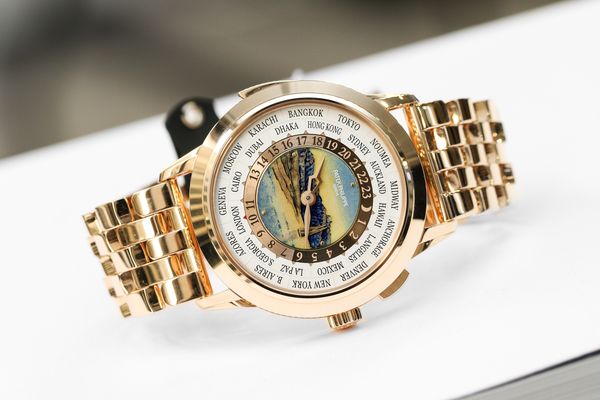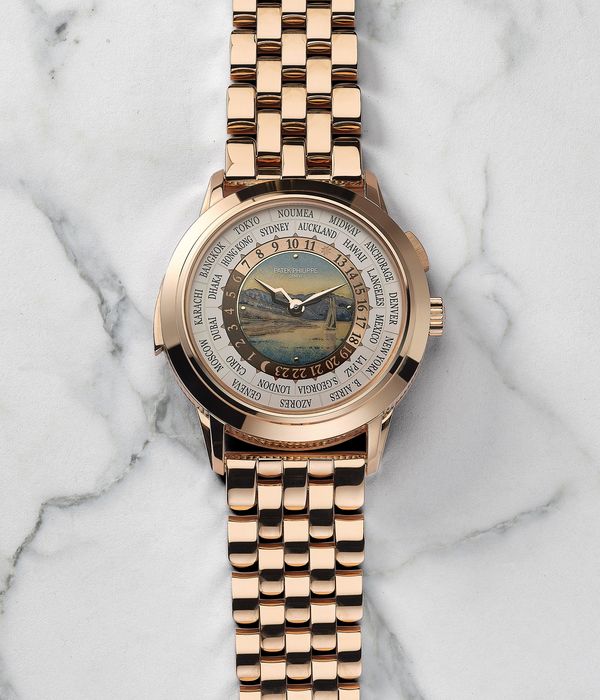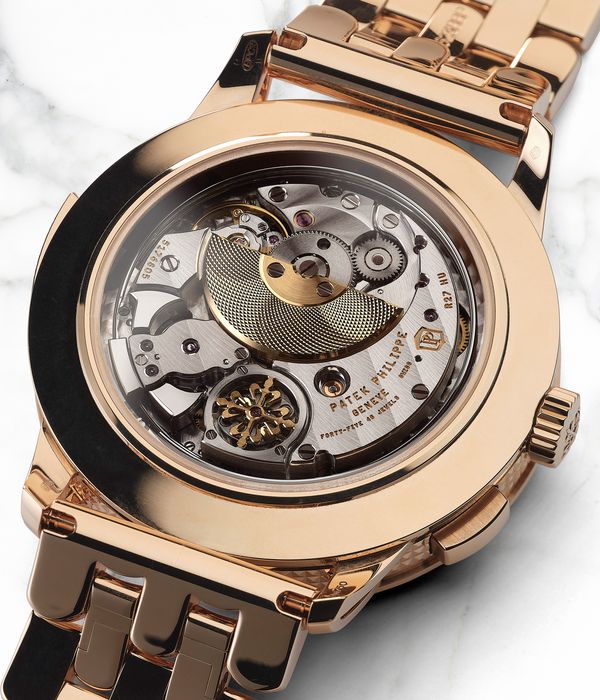Reserved for the early jet set that required the ability to keep track of multiple time zones simultaneously, the world time complication has held an elevated position since it made its serial production debut with the Patek Philippe reference 1415 in 1939. Due to low production numbers, and sparsely offered references over the decades since its inception, it is easy to trace the continual lineage of Louis Cottier’s work with Patek Philippe, but it is curious to note that along the path, there are very few instances of the world time city ring appearing with another complication.
Early on in its existence there was the reference 1415 with chronograph added that was produced for a doctor (easy to recognise with the pulsation scale) that would directly inspire the modern reference 5930 world time chronograph, but even with a significant amount of consideration, it is hard to think of further examples beyond those fitted with moon phase for the company’s 175th anniversary, references 5575 and 7175.
This would all change in 2017: as Patek Philippe prepared for their second running of the Grand Exhibition in New York (the first having taken place in London in 2015), it was well known to the collectors’ community that there would be a series of coveted limited edition models to commemorate the event. And while it was the reference 5522A steel Pilot’s Calatrava that would attract the attention of the masses, for the most savant collector there was delightful surprise in the arrival of the 5531R World Time Minute Repeater.
On the surface, it appeared to be an automatic minute repeating calibre R 27 that has been used as a base for watches such as the reference 5078 and the 5208, fitted with the world time module on top, but of course this is a wild over simplification of the set up. Patek Philippe being Patek Philippe used the reference 5531 as an opportunity to debut a patented mechanism that allows the watch to always chime the local time, rather than a base home time, achieved by creating a mechanism that drives the hour wheel from the world time disc for the repeater works to accurately “read” what the dial displays.
The innovation did not stop there either, with the house of the Calatrava cross integrating a safety feature that blocks the world time advancing button when the chime is actuated, to ensure that the movement is not damaged. For aural quality, the gongs are mounted onto the case rather than the movement base plate as it would be traditionally, allowing for the chime to be heard more clearly. Perhaps the most curious advance for the minute repeater concept with the 5531R is the ability for the calibre to chime the correct time at the end of the striking run at the top of the hour. For example, if the repeater slide is actuated at 11:59.50, it will strike the low-pitch hour gong 12 times, ensuring the user hears the most accurate time.
On top of the technical sophistication of the movement, the case also features of number of beautiful details, such as clous de Paris engraving on the band, even extending to the repeater slide, and open-worked lugs that given the impression of an open and airy structure, while also allowing the fine engraving to be admired from all angles. With its Goldilocks proportions at 40.2 mm diameter and 11.49 mm in thickness, complemented by the option to fit either a solid or exhibition back, both included with the watch, it is impressive to consider how practically wearable a watch that bore a retail price of approximately 500,000 Swiss francs really is.
During the New York Grand Exhibition, the 5531R was offered as two editions of five watches, one showing the Manhattan skyline by day, and the other at night, realised in incredibly beautiful grand feu enamel tones by the celebrated artist Anita Porchet; it was an inevitability that each individual fortunate enough to be selected to receive one of the 10 total pieces had to be personally approved by Mr. Thierry Stern.
Many would be left disappointed by such a short production run, but it was not a feeling that would last long, as at Baselworld in 2018 the reference 5531R would enter the standard production catalogue, although would continue to be highly limited due to the challenges of producing the complication, in addition to the rigorous qualification process for those clients who were close enough to the brand to be deemed worthy. There were a few tangible changes to the design, most notably a revised scene to the centre of the dial featuring a view of the Lavaux vineyards on the shores of Lake Geneva (a UNESCO world heritage site) with a traditional barque sailing by, still realised in fine grand feu cloisonné enamel featuring 22 colours and approximately 13cm of fine gold wire. The other small update was to substitute the name of Paris that traditionally appears on the world time ring with that of Geneva to reflect the scene depicted, and this important reference’s origin.
It is fascinating to note that even during the short production life so far, there have been a number of special executions, including a select few watches known to have been originally fitted with rose gold bracelets, and an edition of five pieces for the 2019 Grand Exhibition in Singapore featuring a map of the city state and its name, substituting that of Beijing to mark the occasion. All of this goes to show how perfect an encapsulation the reference 5531R is for showing what makes Patek Philippe special: technical achievement, elegant design language, respect for the company’s heritage, and an understanding of how important their most ardent collectors are.


